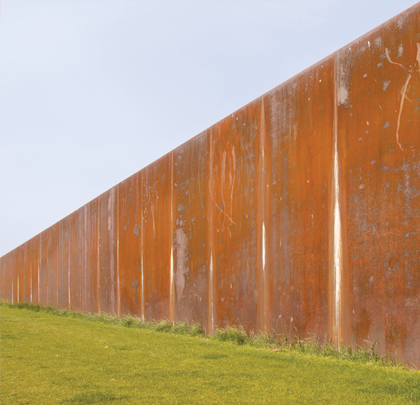Part 2: Understanding the material and choosing filler metals for the job
Weathering steels are often a viable option when atmospheric corrosion is a concern for the job. These materials feature additions of copper, nickel, and chromium that help improve the atmospheric corrosion resistance of the steel. As a result, weathering steel structures are often left largely unpainted, reducing or eliminating a source of added time and cost. Because many of these materials also provide good mechanical properties, weathering steels are commonly used for bridges and other load-bearing structures.
When choosing a filler metal there are questions to consider as they relate to joint geometry and required weld size, relative to material mechanical properties.
Does the base material have a minimum yield strength requirement of 50 ksi?
Will the weld be completed in one pass, or one pass on each side of the weldment?
If the weld is a fillet weld, will the leg sizes be less than or equal to 5/16 inch when using solid wire, metal-cored wire, or flux cored wires, or 1/4 inch when using stick electrodes?
In Part 1 of the article, answering “yes” to the above questions was discussed, now let’s look at the “no” response.
LOW ALLOY FILLER METALS
Answering “no” to the above questions about joint geometry, weld size, and material strength indicates that a low alloy filler metal may be needed to provide the appropriate corrosion resistance and/or mechanical properties when welding weathering steel.
Large, multi-pass welds typically do not experience a significant amount of base metal dilution. For that reason, carbon steel filler metals may not pick up enough alloying elements from the base material to provide the necessary atmospheric corrosion resistance. Instead, a low alloy filler metal is recommended to ensure that the weld will have the same corrosion resistance as the weathering steel.
Low alloy filler metals are available with higher tensile and yield strengths than carbon steel filler metals, allowing the properties of the filler metal to match those of the base metal when welding the higher-strength grades of weathering steel, such as HPS 70W of the AASHTO M270 specification.
Commonly used low alloy filler metals for weathering steel applications include those with a minimum nominal nickel content of one percent. That alloy content is sufficient to provide atmospheric corrosion resistance similar to the weathering steel, and the cost is typically less than other low alloy filler metals with acceptable properties. The most common alloy designators with this one percent nominal content are Ni1 (for wires) and C3 (for stick electrodes), although many other designators indicate filler metals with sufficient nickel in addition to other elements.
Filler metals with a higher nickel content also can be used successfully, and they may be demanded in certain applications, since higher nickel content enhances toughness. However, the price of a filler metal typically increases significantly as the nickel and general alloy content also increases.
Copper-nickel-chromium-bearing low alloy steel filler metals have a nominal alloy content similar to many weathering steels and are indicated by “W” alloy designators. These filler metals are almost exclusively used in applications where color-match (discussed below) is a primary concern. However, they tend to cost more, are often less readily available, and are somewhat more crack-sensitive than alternative filler metals.
Many of the most commercially available low alloy filler metals for welding weathering steel offer 80-plus ksi tensile strength and 60-plus ksi yield strength, but these filler metals are over-matched (higher strength than required) for the base metal when used to weld on 50 ksi yield weathering steel. While this over-match doesn’t provide a structural advantage, many codes and engineers allow it to ensure corrosion-resistant alloying of welds with more readily available filler metals. On 50 ksi yield materials, when permissible, combining carbon steel and low alloy filler metals can provide good results and lower filler metal costs, particularly on very large multi-pass welds. Use a carbon steel filler metal for all welding up to the final two layers of the weld joint, then weld the last two layers using the more expensive low alloy filler metal to ensure that the weld face still has the elements it needs to resist corrosion.
COLOR-MATCHING APPLICATIONS
Given enough time, all welds will eventually adopt a patina of their own regardless of whether carbon steel or low alloy filler metals are used. However, welds on weathering steels are initially highly visible due to the contrast between the matte brown color of the material and the glossy grey color of the weld metal. In some applications, such as sculptures or certain architectural details having welds in the public eye, it is desirable to have the appearance of the weld match the base material both in color and texture, as soon as possible. The ability for this to occur quickly with seamless appearance is known as color matching.
Low alloy steel filler metals with a “W” designator are typically used for these applications, as they are capable of forming a patina more quickly that matches the unique colors of the weathering steel than other alternatives.
Small welds with high dilution also are likely to color match relatively quickly, even when not made with “W” designator filler metals. Still, they may not blend as seamlessly and as quickly as when using “W” filler metals.
MAXIMIZE THE BENEFITS
Choosing the appropriate filler metal plays a key role in realizing the benefits offered by weathering steels. When selecting a filler metal, consider all aspects of the welding application—from code, strength, and toughness requirements to aesthetics—to gain the best results. When in doubt, contact the technical support services of filler metal manufacturers; their staff can help identify which products in their portfolio will help maximize the performance of the welding application.
■ ■ ■
[divider]
About The Author Robert Fox is a welding engineer in the applications engineering department of Hobart Brothers Company. For more information, visit www.hobartbrothers.com.


